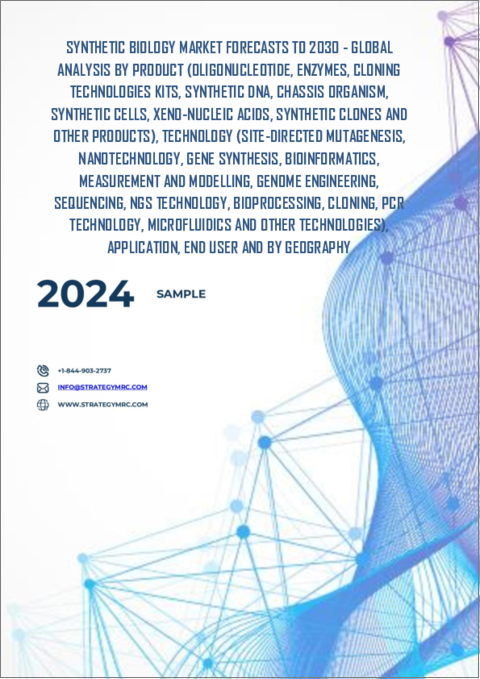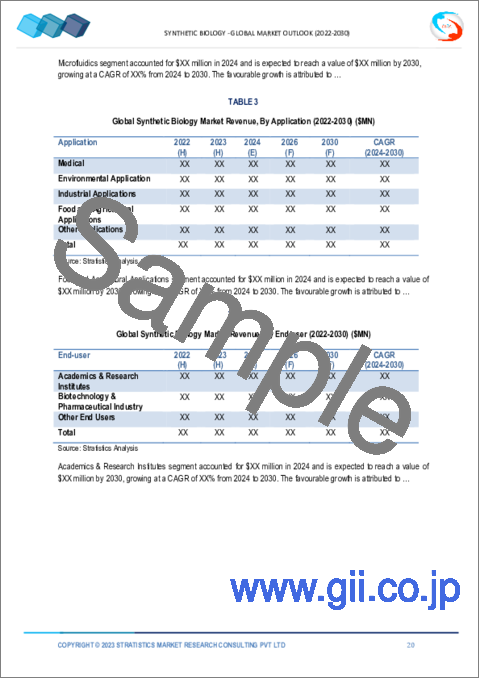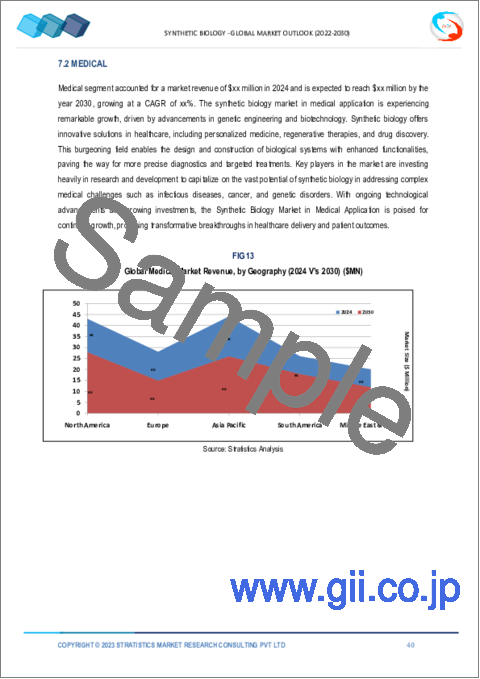|
|
市場調査レポート
商品コード
1402014
合成生物学市場の2030年までの予測:製品、技術、用途、エンドユーザー、地域別の世界分析Synthetic Biology Market Forecasts to 2030 - Global Analysis By Product, Technology, Application, End User and By Geography |
||||||
カスタマイズ可能
|
|||||||
| 合成生物学市場の2030年までの予測:製品、技術、用途、エンドユーザー、地域別の世界分析 |
|
出版日: 2023年12月01日
発行: Stratistics Market Research Consulting
ページ情報: 英文 200+ Pages
納期: 2~3営業日
|
- 全表示
- 概要
- 図表
- 目次
Stratistics MRCによると、世界の合成生物学市場は2023年に155億米ドルを占め、予測期間中にCAGR 19%で成長し、2030年には526億米ドルに達すると予測されています。
合成生物学は、医療健康サービスの開発を改善するために、現代科学を使って生物を工学的に構築する生物学の先端分野です。その用途はさまざまで、細胞シグナル伝達、ワクチン開発、抗体産生などが含まれます。このプロセスには、感染症、免疫疾患、ガン性疾患など、さまざまな病気の治療における新規治療標的を特定するために必要な特定の代謝経路が含まれます。
SynBioBetaのデータによると、合成生物学分野の新興企業は2021年に180億米ドルを調達しました。
合成バイオテクノロジーの用途拡大
病原体、汚染、気候変動の危機がもたらす脅威の増大により、合成生物学の研究開発への資金が増加しています。合成生物学の採用は、地球気温のさらなる上昇を防ぐために二酸化炭素排出量の削減を目指すいくつかの産業で増加しています。これは、環境に悪影響を及ぼすことなく、必要不可欠な化学物質や材料の特性を再現できる技術のためです。そのため、合成生物学の研究開発が活発化しており、その応用範囲が広がっていることが市場を牽引しています。
バイオの安全性に関する懸念
科学目的などで意図的または非意図的に合成生物を環境中に放出することは、合成生物学における主要生物学的安全性リスクとなります。合成微生物が大気中に投入されると、突然変異を起こしたり、既存の種と相互作用したりする可能性があり、その結果、交雑やバイオエラーが発生します。こうした結果、野生動物の生息地が危険にさらされる可能性があります。さらに、バイオの安全保障に対する深刻な脅威は、抗生物質に耐性を持つウイルスの出現です。こうした制約は、今後数年間の市場拡大を妨げる可能性があります。
医療への応用拡大
創薬においては、合成生物学はカスタム生物学的回路を構築することで治療化合物の同定と開発を加速します。これは医薬品開発の効率を高めるだけでなく、より効果的で標的を絞った医薬品の創出に道を開くものでもあります。さらに、合成生物学はバイオ医薬品の生産においても重要な役割を果たしており、治療用タンパク質やワクチンを合成するための微生物の工学的利用を可能にしています。医療におけるこうした用途の拡大は、市場の需要を後押ししています。
限られた予測可能性
合成生物や工学的に設計された生物学的回路の挙動はしばしば予測不可能であり、研究者や開発者に課題を突きつけています。生物学的構成要素の複雑な相互作用は、予期せぬ行動の出現や、合成システムが意図したとおりに機能しないといった、予期せぬ結果をもたらす可能性があります。しかし、このような予測可能性の欠如は、合成生物学的システムの効率的な設計と最適化の妨げとなり、時間と資源を要する試行錯誤的なアプローチにつながります。したがって、限られた予測可能性が市場の成長を妨げる重要な要素となっています。
COVID-19の影響
合成生物学市場は、COVID-19のパンデミック(世界的大流行)時に、生産量の減少、閉鎖、労働力不足などの理由で、当初はわずかながら成長が鈍化しました。しかし、COVID-19管理のための新規治療薬、ワクチン、診断薬に対するニーズが高まったため、最終的に市場は再び成長しました。医薬品の開発とCOVIDワクチンの研究が合成生物学の研究を支えました。
予測期間中、シャーシ生物セグメントは最大になる見込み
シャーシ生物セグメントは最大のシェアを占めると推定されます。これらのシャーシ生物は、遺伝子回路やコンポーネントを統合して新規機能性や改変された生物学的プロセスを創出するために不可欠な生物学的枠組みを提供します。大腸菌のような細菌やサッカロマイセス・セレビシエのような酵母は、頻繁に使用されるシャーシ生物です。これらの生物は、遺伝的背景がよく理解されていること、操作が容易であること、遺伝子工学のためのツールが確立されていることから選ばれています。シャーシ生物というこの分野の核となる考え方は、合成生物学における革新と発展を促進します。
予測期間中、PCR技術セグメントのCAGRが最も高くなると予測されています。
PCR技術セグメントは予測期間中に有利な成長を遂げると予測されています。ポリメラーゼ連鎖反応(PCR)は、特定の遺伝子配列を検出し分析するための重要な技術として発展してきました。ほとんどのPCRベースのゲノム研究では、リアルタイムPCR検査が、その卓越した感度と特異性により好まれるアプローチです。このアプローチは法医学分析、分子診断、DNAクローニング、ゲノミクスで一般的に利用されています。
最大シェアの地域
推定期間中、北米が最大の市場シェアを占めました。合成生物学を医薬品開発プロセスに利用している世界の企業や学術機関の大半は北米に所在しています。この地域のコンピューター能力、人工知能、ゲノムマッピングの進歩により、研究者たちは新しい手法をいち早く取り入れ、既存の概念に基づいて新たな能力を生み出すようになった。さらに、何千人もの研究者、科学者、学術機関、政府部門、民間投資家、製品エンジニアの協力が、この地域の市場を新たな発見で前進させています。
CAGRが最も高い地域:
アジア太平洋は、予測期間中に収益性の高い成長を遂げると予想されます。アジア太平洋における投資の増加、中国市場における資金提供や提携の増加、合成生物学分野における協力関係の強化などは、市場成長を促進すると予想される要因の一部です。さらに、新規治療薬の開発に向けた合成生物学の応用において、アジアは重要な役割を果たすことができる立場にあります。アジアの政府や民間投資家は、合成生物学の研究や技術移転への関心を高めており、この分野は持続可能なバイオベース経済の育成に大きな期待を寄せています。
無料カスタマイズサービス:
本レポートをご購読のお客様には、以下の無料カスタマイズオプションのいずれかをご利用いただけます。
- 企業プロファイル
- 追加市場参入企業の包括的プロファイリング(3社まで)
- 主要企業のSWOT分析(3社まで)
- 地域セグメンテーション
- 顧客の関心に応じた主要国の市場推定・予測・CAGR(注:フィージビリティチェックによる)
- 競合ベンチマーキング
- 製品ポートフォリオ、地理的プレゼンス、戦略的提携に基づく主要企業のベンチマーキング
目次
第1章 エグゼクティブサマリー
第2章 序文
- 概要
- ステークホルダー
- 調査範囲
- 調査手法
- データ鉱業
- データ分析
- データ検証
- 調査アプローチ
- 調査情報源
- 1次調査情報源
- 2次調査情報源
- 前提条件
第3章 市場動向分析
- イントロダクション
- 促進要因
- 抑制要因
- 機会
- 脅威
- 製品分析
- 用途分析
- エンドユーザー分析
- 新興市場
- 新型コロナウイルス感染症(COVID-19)の影響
第4章 ポーターのファイブフォース分析
- 供給企業の交渉力
- 買い手の交渉力
- 代替品の脅威
- 新規参入業者の脅威
- 競争企業間の敵対関係
第5章 世界の合成生物学市場:製品別
- イントロダクション
- オリゴヌクレオチド
- 酵素
- クローン技術キット
- 合成DNA
- シャーシ生物
- 合成細胞
- 異種核酸
- 合成クローン
- その他の製品
第6章 世界の合成生物学市場:技術別
- イントロダクション
- 部位特異的突然変異誘発
- ナノ技術
- 遺伝子合成
- バイオインフォマティクス
- 測定とモデリング
- ゲノム工学
- シーケンス
- NGS技術
- バイオプロセシング
- クローン作成
- PCR技術
- マイクロ流体工学
- その他の技術
第7章 世界の合成生物学市場:用途別
- イントロダクション
- 医学
- 創薬と治療
- 医薬品
- 人工組織と組織再生
- 環境用途
- バイオセンシング
- バイオレメディエーション
- 産業用途
- 工業用酵素
- バイオ燃料と再生可能エネルギー
- バイオマテリアルとエコケミカル
- 食品と農業への応用
- フレーバーとフレグランス
- その他の用途
第8章 世界の合成生物学市場:エンドユーザー別
- イントロダクション
- 学術研究機関
- バイオテクノロジーと製薬産業
- その他のエンドユーザー
第9章 世界の合成生物学市場:地域別
- イントロダクション
- 北米
- 米国
- カナダ
- メキシコ
- 欧州
- ドイツ
- 英国
- イタリア
- フランス
- スペイン
- その他の欧州
- アジア太平洋
- 日本
- 中国
- インド
- オーストラリア
- ニュージーランド
- 韓国
- その他のアジア太平洋
- 南米
- アルゼンチン
- ブラジル
- チリ
- その他の南米
- 中東とアフリカ
- サウジアラビア
- アラブ首長国連邦
- カタール
- 南アフリカ
- その他の中東とアフリカ
第10章 主要発展
- 契約、パートナーシップ、コラボレーション、合弁事業
- 買収と合併
- 新製品の発売
- 事業拡大
- その他の主要戦略
第11章 企業プロファイル
- Synbio Technologies
- GenScript
- Agilent Technologies, Inc.
- Eurofins Genomics GmbH
- Thermo Fisher Scientific
- Amyris
- Merck KGaA
- Codexis, Inc.
- Integrated DNA Technologies, Inc.
- Synthego
- EnBiotix, Inc.
- Genomatica, Inc.
- New England Biolabs(英国)Ltd.
- Scarab Genomics, LLC
List of Tables
- Table 1 Global Synthetic Biology Market Outlook, By Region (2021-2030) ($MN)
- Table 2 Global Synthetic Biology Market Outlook, By Product (2021-2030) ($MN)
- Table 3 Global Synthetic Biology Market Outlook, By Oligonucleotide (2021-2030) ($MN)
- Table 4 Global Synthetic Biology Market Outlook, By Enzymes (2021-2030) ($MN)
- Table 5 Global Synthetic Biology Market Outlook, By Cloning Technologies Kits (2021-2030) ($MN)
- Table 6 Global Synthetic Biology Market Outlook, By Synthetic DNA (2021-2030) ($MN)
- Table 7 Global Synthetic Biology Market Outlook, By Chassis Organism (2021-2030) ($MN)
- Table 8 Global Synthetic Biology Market Outlook, By Synthetic cells (2021-2030) ($MN)
- Table 9 Global Synthetic Biology Market Outlook, By Xeno-Nucleic Acids (2021-2030) ($MN)
- Table 10 Global Synthetic Biology Market Outlook, By Synthetic Clones (2021-2030) ($MN)
- Table 11 Global Synthetic Biology Market Outlook, By Other Products (2021-2030) ($MN)
- Table 12 Global Synthetic Biology Market Outlook, By Technology (2021-2030) ($MN)
- Table 13 Global Synthetic Biology Market Outlook, By Site-Directed Mutagenesis (2021-2030) ($MN)
- Table 14 Global Synthetic Biology Market Outlook, By Nanotechnology (2021-2030) ($MN)
- Table 15 Global Synthetic Biology Market Outlook, By Gene Synthesis (2021-2030) ($MN)
- Table 16 Global Synthetic Biology Market Outlook, By Bioinformatics (2021-2030) ($MN)
- Table 17 Global Synthetic Biology Market Outlook, By Measurement and Modelling (2021-2030) ($MN)
- Table 18 Global Synthetic Biology Market Outlook, By Genome Engineering (2021-2030) ($MN)
- Table 19 Global Synthetic Biology Market Outlook, By Sequencing (2021-2030) ($MN)
- Table 20 Global Synthetic Biology Market Outlook, By NGS Technology (2021-2030) ($MN)
- Table 21 Global Synthetic Biology Market Outlook, By Bioprocessing (2021-2030) ($MN)
- Table 22 Global Synthetic Biology Market Outlook, By Cloning (2021-2030) ($MN)
- Table 23 Global Synthetic Biology Market Outlook, By PCR Technology (2021-2030) ($MN)
- Table 24 Global Synthetic Biology Market Outlook, By Microfluidics (2021-2030) ($MN)
- Table 25 Global Synthetic Biology Market Outlook, By Other Technologies (2021-2030) ($MN)
- Table 26 Global Synthetic Biology Market Outlook, By Application (2021-2030) ($MN)
- Table 27 Global Synthetic Biology Market Outlook, By Medical (2021-2030) ($MN)
- Table 28 Global Synthetic Biology Market Outlook, By Drug Discovery and Therapeutics (2021-2030) ($MN)
- Table 29 Global Synthetic Biology Market Outlook, By Pharmaceuticals (2021-2030) ($MN)
- Table 30 Global Synthetic Biology Market Outlook, By Artificial Tissue and Tissue Regeneration (2021-2030) ($MN)
- Table 31 Global Synthetic Biology Market Outlook, By Environmental Applications (2021-2030) ($MN)
- Table 32 Global Synthetic Biology Market Outlook, By Biosensing (2021-2030) ($MN)
- Table 33 Global Synthetic Biology Market Outlook, By Bioremediation (2021-2030) ($MN)
- Table 34 Global Synthetic Biology Market Outlook, By Industrial Applications (2021-2030) ($MN)
- Table 35 Global Synthetic Biology Market Outlook, By Industrial Enzymes (2021-2030) ($MN)
- Table 36 Global Synthetic Biology Market Outlook, By Biofuel and Renewable Energy (2021-2030) ($MN)
- Table 37 Global Synthetic Biology Market Outlook, By Biomaterials and Green Chemicals (2021-2030) ($MN)
- Table 38 Global Synthetic Biology Market Outlook, By Food and Agricultural Applications (2021-2030) ($MN)
- Table 39 Global Synthetic Biology Market Outlook, By Flavors and Fragrances (2021-2030) ($MN)
- Table 40 Global Synthetic Biology Market Outlook, By Other Applications (2021-2030) ($MN)
- Table 41 Global Synthetic Biology Market Outlook, By End user (2021-2030) ($MN)
- Table 42 Global Synthetic Biology Market Outlook, By Academics & Research Institutes (2021-2030) ($MN)
- Table 43 Global Synthetic Biology Market Outlook, By Biotechnology & Pharmaceutical Industry (2021-2030) ($MN)
- Table 44 Global Synthetic Biology Market Outlook, By Other End Users (2021-2030) ($MN)
Note: Tables for North America, Europe, APAC, South America, and Middle East & Africa Regions are also represented in the same manner as above.
According to Stratistics MRC, the Global Synthetic Biology Market is accounted for $15.5 billion in 2023 and is expected to reach $52.6 billion by 2030 growing at a CAGR of 19% during the forecast period. Synthetic biology is an advanced field of biology that uses modern science to engineer organisms in order to improve the development of medical and health services. Its applications vary and include cellular signalling, vaccine development, and antibody production. The process includes specific metabolic pathways that are necessary for identifying novel therapeutic targets for the treatment of a variety of illnesses, including infectious, immunological, and cancerous diseases.
According to SynBioBeta data, startups within the synthetic biology sector raised 18.0 billion in 2021.
Market Dynamics:
Driver:
Rising applications of synthetic biotechnology
The funding for synthetic biology research and development has increased due to the growing threat posed by pathogens, pollution, and the climate change crisis. The adoption of synthetic biology has increased in several industries that aim to lower their carbon footprints in order to prevent further rises in global temperatures. This is due to the technology's ability to replicate the properties of essential chemicals and materials without causing negative environmental effects. Therefore, rising research and development in synthetic biology are widening the scope of its applications, which will drive the market.
Restraint:
Bio safety concerns
The intentional or unintentional release of synthetic organisms into the environment for scientific purposes or other purposes poses the main bio safety risk in synthetic biology. When synthetic microorganisms are put into the atmosphere, they can mutate or interact with existing species, resulting in crossbreeding and bio errors. These consequences may endanger the habitats of wild animals. Moreover, a serious threat to bio security is the emergence of viruses that are resistant to antibiotics. These limitations could hamper market expansion in the coming years.
Opportunity:
Expanding applications in healthcare
In drug discovery, synthetic biology accelerates the identification and development of therapeutic compounds by constructing custom biological circuits. This not only enhances the efficiency of drug development but also opens avenues for the creation of more effective and targeted pharmaceuticals. Additionally, synthetic biology plays a crucial role in biopharmaceutical production, enabling the engineering of microorganisms for the synthesis of therapeutic proteins and vaccines. These rising applications in healthcare propel market demand.
Threat:
Limited predictability
The behavior of synthetic organisms and engineered biological circuits often exhibits unpredictability, posing challenges for researchers and developers. The complex interplay of biological components can result in unintended consequences, such as the emergence of unexpected behaviours or the failure of synthetic systems to perform as intended. However, this lack of predictability hinders the efficient design and optimization of synthetic biological systems, leading to time-consuming and resource-intensive trial-and-error approaches. Therefore, limited predictability is a significant element hampering market growth.
COVID-19 Impact
The synthetic biology market saw a minor downturn in growth during the COVID-19 pandemic, at first because of a decrease in production, then lockdown and a labor shortage. However, the market eventually saw resurgence in growth because of the increased need for novel treatments, vaccines, and diagnostics for COVID-19 management. The development of medications and research on the COVID vaccine supported synthetic biology research.
The chassis organism segment is expected to be the largest during the forecast period
The chassis organism segment is estimated to hold the largest share. These chassis organisms provide the essential biological framework onto which genetic circuits and components can be integrated to create novel functionalities or modified biological processes. Bacteria like Escherichia coli and yeasts like Saccharomyces cerevisiae are frequently used chassis organisms. These organisms are selected for their well-understood genetic backgrounds, ease of manipulation, and established tools for genetic engineering. The field's core idea of chassis organisms promotes innovation and developments in synthetic biology.
The PCR technology segment is expected to have the highest CAGR during the forecast period
The PCR technology segment is anticipated to have lucrative growth during the forecast period. Polymerase Chain Reaction (PCR) has evolved as a crucial technology for detecting and analyzing specific gene sequences. For most PCR-based genomic research, real-time PCR tests are the preferred approach due to their exceptional sensitivity and specificity. This approach is commonly utilized in forensic analysis, molecular diagnostics, DNA cloning, and genomics.
Region with largest share:
North America commanded the largest market share during the extrapolated period. The majority of the world's businesses and academic institutions that use synthetic biology in their drug development processes are located in North America. Advances in computer power, artificial intelligence, and genome mapping in this region have prompted researchers to quickly embrace new methods and build upon pre-existing concepts to create new capacities. Additionally, the cooperation of thousands of researchers, scientists, academic institutions, government departments, private investors, and product engineers has advanced the market in this region with new discoveries.
Region with highest CAGR:
Asia Pacific is expected to witness profitable growth over the projection period. Increasing investments in the Asia-Pacific region, more funding and partnerships in the Chinese market, and more collaboration in the field of synthetic biology are some of the factors anticipated to propel market growth. Additionally, Asia is also well-positioned to play a significant role in the application of synthetic biology toward the development of novel therapeutics. Governments and private investors in Asia are becoming increasingly interested in synthetic biology research and technology translation, where the field holds enormous promise for fostering a sustainable bio-based economy.
Key players in the market:
Some of the key players in the Synthetic Biology Market include Synbio Technologies, GenScript, Agilent Technologies, Inc., Eurofins Genomics GmbH, Thermo Fisher Scientific, Amyris, Merck KGaA, Codexis, Inc., Integrated DNA Technologies, Inc., Synthego, EnBiotix, Inc., Genomatica, Inc., New England Biolabs (UK) Ltd. and Scarab Genomics, LLC.
Key Developments:
In April 2022, Merck KGaA Acquisition of MAST Platform from Lonza, a Leading Automated Bioreactor Sampling System. The acquisition of the MAST platform is another milestone to accelerate innovation in Merck's Process Solutions business unit.
In February 2022, Thermo Fisher Scientific announced the launch of GeneMapper Software, a flexible genotyping software package that provides DNA sizing and quality allele calls for all Thermo Fisher Scientific electrophoresis-based genotyping.
Products Covered:
- Oligonucleotide
- Enzymes
- Cloning Technologies Kits
- Synthetic DNA
- Chassis Organism
- Synthetic cells
- Xeno-Nucleic Acids
- Synthetic Clones
- Other Products
Technologies Covered:
- Site-Directed Mutagenesis
- Nanotechnology
- Gene Synthesis
- Bioinformatics
- Measurement and Modelling
- Genome Engineering
- Sequencing
- NGS Technology
- Bio processing
- Cloning
- PCR Technology
- Microfluidics
- Other Technologies
Applications Covered:
- Medical
- Environmental Applications
- Industrial Applications
- Food and Agricultural Applications
- Other Applications
End Users Covered:
- Academics & Research Institutes
- Biotechnology & Pharmaceutical Industry
- Other End Users
Regions Covered:
- North America
- US
- Canada
- Mexico
- Europe
- Germany
- UK
- Italy
- France
- Spain
- Rest of Europe
- Asia Pacific
- Japan
- China
- India
- Australia
- New Zealand
- South Korea
- Rest of Asia Pacific
- South America
- Argentina
- Brazil
- Chile
- Rest of South America
- Middle East & Africa
- Saudi Arabia
- UAE
- Qatar
- South Africa
- Rest of Middle East & Africa
What our report offers:
- Market share assessments for the regional and country-level segments
- Strategic recommendations for the new entrants
- Covers Market data for the years 2021, 2022, 2023, 2026, and 2030
- Market Trends (Drivers, Constraints, Opportunities, Threats, Challenges, Investment Opportunities, and recommendations)
- Strategic recommendations in key business segments based on the market estimations
- Competitive landscaping mapping the key common trends
- Company profiling with detailed strategies, financials, and recent developments
- Supply chain trends mapping the latest technological advancements
Free Customization Offerings:
All the customers of this report will be entitled to receive one of the following free customization options:
- Company Profiling
- Comprehensive profiling of additional market players (up to 3)
- SWOT Analysis of key players (up to 3)
- Regional Segmentation
- Market estimations, Forecasts and CAGR of any prominent country as per the client's interest (Note: Depends on feasibility check)
- Competitive Benchmarking
- Benchmarking of key players based on product portfolio, geographical presence, and strategic alliances
Table of Contents
1 Executive Summary
2 Preface
- 2.1 Abstract
- 2.2 Stake Holders
- 2.3 Research Scope
- 2.4 Research Methodology
- 2.4.1 Data Mining
- 2.4.2 Data Analysis
- 2.4.3 Data Validation
- 2.4.4 Research Approach
- 2.5 Research Sources
- 2.5.1 Primary Research Sources
- 2.5.2 Secondary Research Sources
- 2.5.3 Assumptions
3 Market Trend Analysis
- 3.1 Introduction
- 3.2 Drivers
- 3.3 Restraints
- 3.4 Opportunities
- 3.5 Threats
- 3.6 Product Analysis
- 3.7 Application Analysis
- 3.8 End User Analysis
- 3.9 Emerging Markets
- 3.10 Impact of Covid-19
4 Porters Five Force Analysis
- 4.1 Bargaining power of suppliers
- 4.2 Bargaining power of buyers
- 4.3 Threat of substitutes
- 4.4 Threat of new entrants
- 4.5 Competitive rivalry
5 Global Synthetic Biology Market, By Product
- 5.1 Introduction
- 5.2 Oligonucleotide
- 5.3 Enzymes
- 5.4 Cloning Technologies Kits
- 5.5 Synthetic DNA
- 5.6 Chassis Organism
- 5.7 Synthetic cells
- 5.8 Xeno-Nucleic Acids
- 5.9 Synthetic Clones
- 5.10 Other Products
6 Global Synthetic Biology Market, By Technology
- 6.1 Introduction
- 6.2 Site-Directed Mutagenesis
- 6.3 Nanotechnology
- 6.4 Gene Synthesis
- 6.5 Bioinformatics
- 6.6 Measurement and Modelling
- 6.7 Genome Engineering
- 6.8 Sequencing
- 6.9 NGS Technology
- 6.10 Bioprocessing
- 6.11 Cloning
- 6.12 PCR Technology
- 6.13 Microfluidics
- 6.14 Other Technologies
7 Global Synthetic Biology Market, By Application
- 7.1 Introduction
- 7.2 Medical
- 7.2.1 Drug Discovery and Therapeutics
- 7.2.2 Pharmaceuticals
- 7.2.3 Artificial Tissue and Tissue Regeneration
- 7.3 Environmental Applications
- 7.3.1 Biosensing
- 7.3.2 Bioremediation
- 7.4 Industrial Applications
- 7.4.1 Industrial Enzymes
- 7.4.2 Biofuel and Renewable Energy
- 7.4.3 Biomaterials and Green Chemicals
- 7.5 Food and Agricultural Applications
- 7.5.1 Flavors and Fragrances
- 7.6 Other Applications
8 Global Synthetic Biology Market, By End user
- 8.1 Introduction
- 8.2 Academics & Research Institutes
- 8.3 Biotechnology & Pharmaceutical Industry
- 8.4 Other End Users
9 Global Synthetic Biology Market, By Geography
- 9.1 Introduction
- 9.2 North America
- 9.2.1 US
- 9.2.2 Canada
- 9.2.3 Mexico
- 9.3 Europe
- 9.3.1 Germany
- 9.3.2 UK
- 9.3.3 Italy
- 9.3.4 France
- 9.3.5 Spain
- 9.3.6 Rest of Europe
- 9.4 Asia Pacific
- 9.4.1 Japan
- 9.4.2 China
- 9.4.3 India
- 9.4.4 Australia
- 9.4.5 New Zealand
- 9.4.6 South Korea
- 9.4.7 Rest of Asia Pacific
- 9.5 South America
- 9.5.1 Argentina
- 9.5.2 Brazil
- 9.5.3 Chile
- 9.5.4 Rest of South America
- 9.6 Middle East & Africa
- 9.6.1 Saudi Arabia
- 9.6.2 UAE
- 9.6.3 Qatar
- 9.6.4 South Africa
- 9.6.5 Rest of Middle East & Africa
10 Key Developments
- 10.1 Agreements, Partnerships, Collaborations and Joint Ventures
- 10.2 Acquisitions & Mergers
- 10.3 New Product Launch
- 10.4 Expansions
- 10.5 Other Key Strategies
11 Company Profiling
- 11.1 Synbio Technologies
- 11.2 GenScript
- 11.3 Agilent Technologies, Inc.
- 11.4 Eurofins Genomics GmbH
- 11.5 Thermo Fisher Scientific
- 11.6 Amyris
- 11.7 Merck KGaA
- 11.8 Codexis, Inc.
- 11.9 Integrated DNA Technologies, Inc.
- 11.10 Synthego
- 11.11 EnBiotix, Inc.
- 11.12 Genomatica, Inc.
- 11.13 New England Biolabs (UK) Ltd.
- 11.14 Scarab Genomics, LLC






